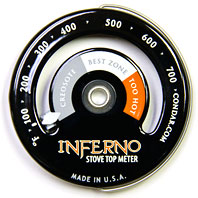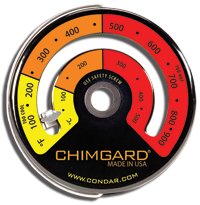Hello all!
I've been doing a lot of research here and have found some great information! Thank you all for your knowledgeable contributions!
I'll get right to the point. I have a new Jotul F55. It's an amazing stove! It's installed in a brick fireplace that's fitted with a 6" stainless liner. The brick chimney is about 3' x 2' with the liner running up the center of the cavity. I have the stove rear vented directly into a 90 and up about a foot of black pipe to the liner.
After reading the forums I determined that the stovepipe thermometer had to get thrown into a snowbank. If I were to let the stove operation continue to be dictated by the stovepipe readings I fear that I would be wasting wood while being cold and allowing creosote to build up.
I have since been asked (commanded) to go dig the thermometer out of the snow and reinstall it. I have refused to since I feel that operating the stove within the parameters of the "safe" zone is not doing us any big favors. As soon as the needle comes within a quarter inch of the "call the fire department and evacuate the house" red zone, it gets turned down despite the fact that the stove is still under 500 degrees.
I just feel that a steel tube inside of a brick chimney could probably sustain the blue blazes of the underworld surging through it for an hour or so...... much less the heat from a really nice stove.
You all probably know why I'm posting this question. Please, feel free to inquire about more specifics relating to my current setup. I just think that it would be helpful to all forum readers (especially me) to be able to assess exactly how much risk I run by not using that darn thermometer.
Please folks, help a guy out here. If you need pictures, I'll take them. More info? I'll give it to you! I could use all of the advice that I can get (all right here in a convenient single thread that I can easily review with loved ones). Otherwise I'm probably going to be residing with the thermometer in that snowbank soon.
I've been doing a lot of research here and have found some great information! Thank you all for your knowledgeable contributions!
I'll get right to the point. I have a new Jotul F55. It's an amazing stove! It's installed in a brick fireplace that's fitted with a 6" stainless liner. The brick chimney is about 3' x 2' with the liner running up the center of the cavity. I have the stove rear vented directly into a 90 and up about a foot of black pipe to the liner.
After reading the forums I determined that the stovepipe thermometer had to get thrown into a snowbank. If I were to let the stove operation continue to be dictated by the stovepipe readings I fear that I would be wasting wood while being cold and allowing creosote to build up.
I have since been asked (commanded) to go dig the thermometer out of the snow and reinstall it. I have refused to since I feel that operating the stove within the parameters of the "safe" zone is not doing us any big favors. As soon as the needle comes within a quarter inch of the "call the fire department and evacuate the house" red zone, it gets turned down despite the fact that the stove is still under 500 degrees.
I just feel that a steel tube inside of a brick chimney could probably sustain the blue blazes of the underworld surging through it for an hour or so...... much less the heat from a really nice stove.
You all probably know why I'm posting this question. Please, feel free to inquire about more specifics relating to my current setup. I just think that it would be helpful to all forum readers (especially me) to be able to assess exactly how much risk I run by not using that darn thermometer.
Please folks, help a guy out here. If you need pictures, I'll take them. More info? I'll give it to you! I could use all of the advice that I can get (all right here in a convenient single thread that I can easily review with loved ones). Otherwise I'm probably going to be residing with the thermometer in that snowbank soon.









 **
**